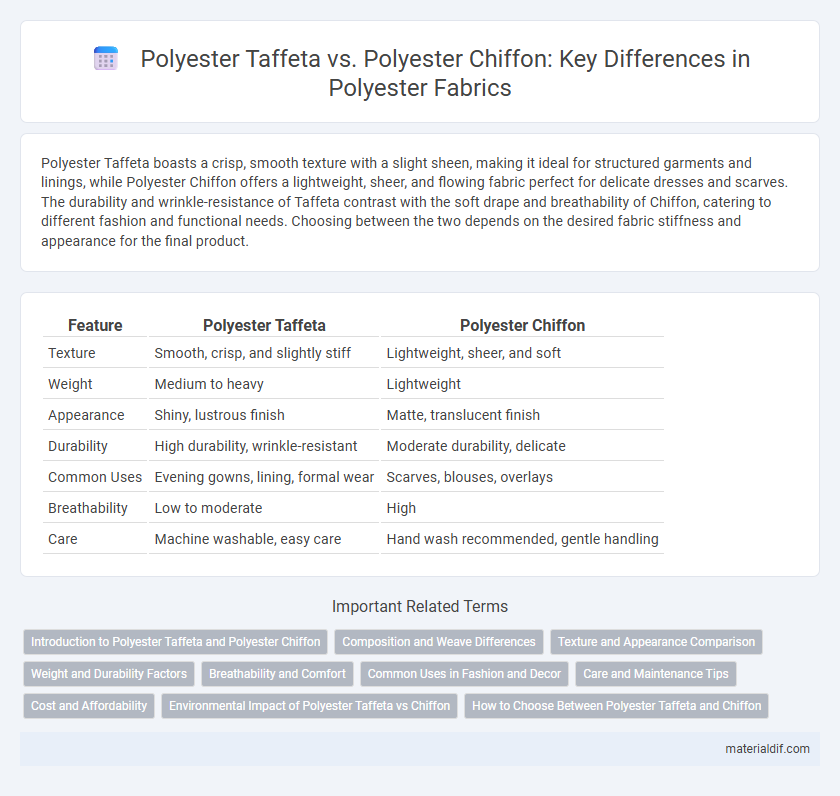Polyester Taffeta boasts a crisp, smooth texture with a slight sheen, making it ideal for structured garments and linings, while Polyester Chiffon offers a lightweight, sheer, and flowing fabric perfect for delicate dresses and scarves. The durability and wrinkle-resistance of Taffeta contrast with the soft drape and breathability of Chiffon, catering to different fashion and functional needs. Choosing between the two depends on the desired fabric stiffness and appearance for the final product.
Table of Comparison
| Feature | Polyester Taffeta | Polyester Chiffon |
|---|---|---|
| Texture | Smooth, crisp, and slightly stiff | Lightweight, sheer, and soft |
| Weight | Medium to heavy | Lightweight |
| Appearance | Shiny, lustrous finish | Matte, translucent finish |
| Durability | High durability, wrinkle-resistant | Moderate durability, delicate |
| Common Uses | Evening gowns, lining, formal wear | Scarves, blouses, overlays |
| Breathability | Low to moderate | High |
| Care | Machine washable, easy care | Hand wash recommended, gentle handling |
Introduction to Polyester Taffeta and Polyester Chiffon
Polyester Taffeta features a crisp, smooth surface with a tightly woven structure, making it ideal for structured garments and lining due to its durability and sheen. Polyester Chiffon is lightweight, sheer, and delicately textured, offering a soft drape perfect for flowing dresses and scarves. Both fabrics are synthetic, wrinkle-resistant, and easy to care for, but their distinct textures and weights cater to different fashion and decor applications.
Composition and Weave Differences
Polyester Taffeta is made from tightly woven, plain-weave polyester fibers, creating a crisp texture with a smooth, lustrous surface ideal for structured garments. Polyester Chiffon features a lightweight, sheer, and semi-transparent fabric crafted from loosely woven polyester yarns, resulting in a soft, flowing drape. The distinct weave and fiber density in Taffeta versus Chiffon significantly influence their opacity, texture, and use in fashion design.
Texture and Appearance Comparison
Polyester Taffeta features a crisp, smooth texture with a lustrous sheen, making it ideal for structured garments and evening wear. In contrast, Polyester Chiffon offers a lightweight, sheer, and slightly rough texture that provides a flowing, elegant appearance suitable for overlays and delicate designs. The distinct differences in texture and appearance between these fabrics influence their best uses in fashion and accessories.
Weight and Durability Factors
Polyester taffeta is a heavier fabric, typically ranging from 70 to 150 grams per square meter, known for its crisp texture and high durability, making it ideal for structured garments and outerwear. Polyester chiffon is lightweight, usually between 30 to 50 grams per square meter, offering a sheer and flowing quality but with less durability and greater susceptibility to snags and wear. The denser weave of taffeta provides superior abrasion resistance and shape retention compared to the delicate, loosely woven chiffon.
Breathability and Comfort
Polyester taffeta offers a crisp texture with moderate breathability, making it suitable for structured garments while maintaining a polished look. Polyester chiffon features a lightweight, sheer weave that enhances airflow and provides superior comfort in warm conditions. Both fabrics are durable, but chiffon excels in breathability and softness, ideal for draped, flowy designs.
Common Uses in Fashion and Decor
Polyester Taffeta is commonly used in fashion for structured garments like evening gowns, jackets, and linings due to its smooth, crisp texture and durability. It is also favored in home decor for items such as curtains, tablecloths, and upholstery because of its ability to hold shape and resist wrinkles. Polyester Chiffon, with its lightweight and sheer quality, is popular in fashion for flowing dresses, scarves, and blouses, while in decor, it is often used for delicate draperies and decorative overlays that require a soft, translucent appearance.
Care and Maintenance Tips
Polyester Taffeta requires gentle washing in cold water and air drying to maintain its crisp texture and prevent wrinkles, while avoiding high heat that can cause damage. Polyester Chiffon demands delicate handling, preferably hand washing with mild detergent and laying flat to dry to preserve its lightweight, sheer quality and prevent fraying. Both fabrics benefit from low-temperature ironing with a pressing cloth to avoid melting or shine on the synthetic fibers.
Cost and Affordability
Polyester taffeta is generally more affordable than polyester chiffon due to its denser weave and lower production costs, making it a cost-effective choice for durable garments and linings. Polyester chiffon, with its lightweight and sheer texture, commands a higher price reflecting its delicate manufacturing process and suitability for elegant, flowy apparel. Budget-conscious buyers often prefer taffeta for everyday use, while chiffon is favored for special occasions despite the premium cost.
Environmental Impact of Polyester Taffeta vs Chiffon
Polyester taffeta and polyester chiffon both contribute to environmental concerns due to their synthetic polyester base, which is derived from non-renewable petroleum resources and is non-biodegradable. Taffeta's densely woven texture requires more energy and chemicals in manufacturing compared to chiffon, which is lightweight and loosely woven, potentially reducing its environmental footprint slightly. Both fabrics shed microplastics during washing, posing risks to aquatic ecosystems, but chiffon's delicate weave may exacerbate fiber loss compared to the sturdier taffeta.
How to Choose Between Polyester Taffeta and Chiffon
Choosing between polyester taffeta and chiffon depends on the desired texture and purpose of the garment, as taffeta offers a crisp, smooth finish ideal for structured dresses and formal wear, while chiffon provides a lightweight, sheer quality suited for flowy, delicate designs. Consider the fabric's weight and drape; taffeta is heavier with a slight sheen, making it perfect for garments requiring body and shape, whereas chiffon is airy and translucent, enhancing softness and movement. The selection should align with the style requirements and comfort, ensuring the fabric complements the garment's function and aesthetic.
Polyester Taffeta vs Polyester Chiffon Infographic

 materialdif.com
materialdif.com